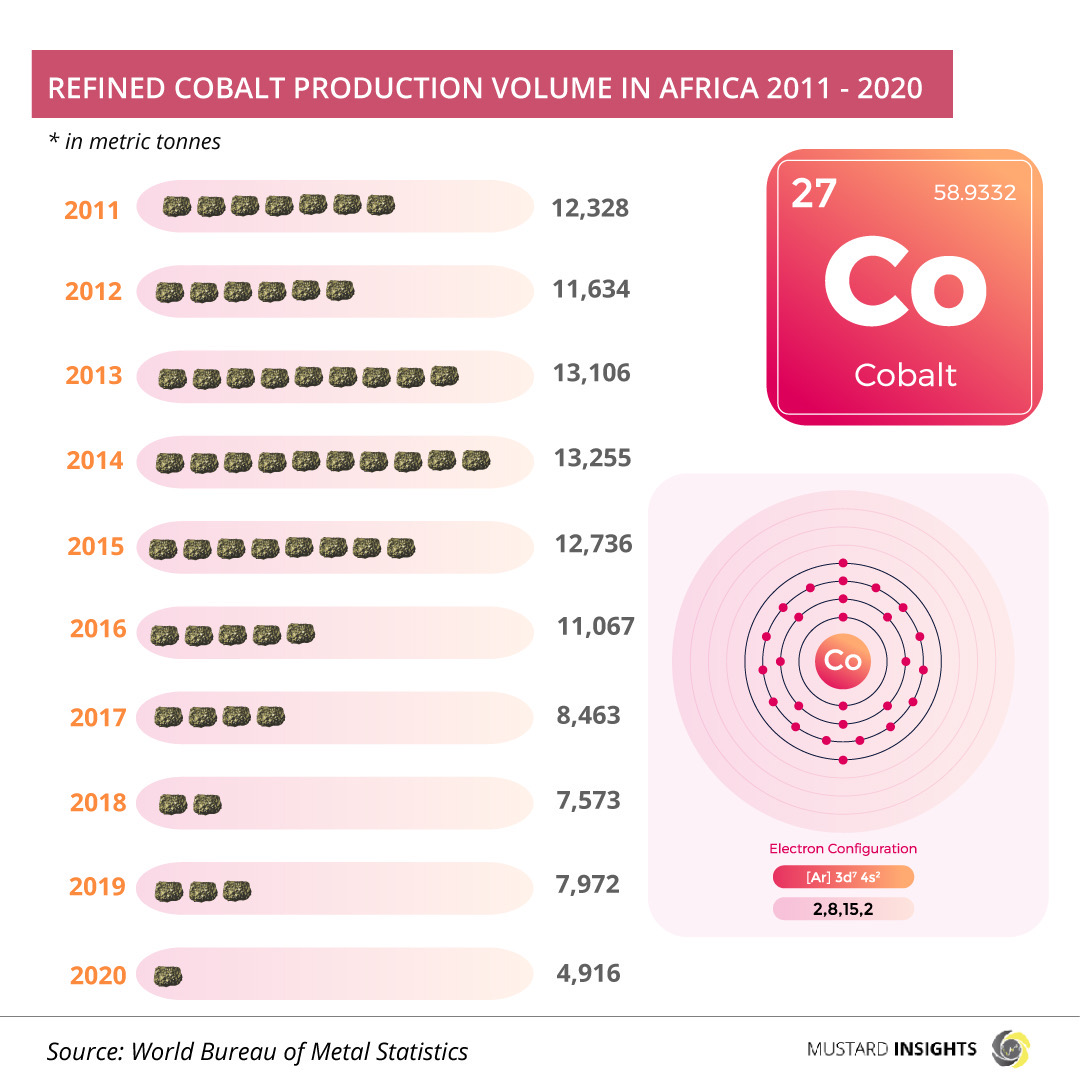Cobalt mining hits its lowest levels in over a decade and is a growing cause for concern across Africa. The production of refined cobalt (plus the cobalt content of salts) in the African continent has decreased from its highs of 13,255 metric tonnes in 2014 to about 4,916 metric tonnes in 2020.
Cobalt is a metal used in many commercial, industrial, and military fields. The metal has emerged as a vital ingredient in the shift to a lower-carbon energy system through its use in the production of lithium-ion batteries for electric cars and other forms of energy storage among others. In military operations, it is useful in preparing ultra-strong and wear resistant magnetic alloys, as a radioactive tracer and in producing high energy gamma rays. Another application of cobalt is in giving inks, paints, varnishes, and ceramics and glass a distinctive deep blue colour.
Breakdown and key metrics
Over 70% of the world’s cobalt comes from the Democratic Republic of Congo (DRC), with 15% to 30% of the Congolese cobalt being produced by Artisanal and Small-scale Mining (ASM). The mines that extract cobalt are in the Lualaba Province in Southern Congo. This copper belt region mines cobalt as a by-product of copper mining. Also, DR Congo contains at least 50% of the known cobalt reserves around the world.
Analysis of data provided by the World Bureau of Metal Statistics show that despite fluctuations between highs and lows in cobalt production volume in Africa from 2011 to 2014, refined cobalt production in Africa has been on a steady decline, dropping by about 170% between 2014 and 2020. The production of refined cobalt (plus the cobalt content of cobalt salts) in the African continent decreased from 13,255 metric tons in 2014 to about 4,916 metric tons in 2020.
This decline in cobalt production is largely because of efforts by the International Energy Agency (IEA) to develop new supply chains for cobalt, based on the challenges of having most of the world’s reserves in DR Congo.
In 2020, Africa accounted for approximately 3.9% of the global cobalt production compared to the continent’s cobalt output in 2013, accounting for nearly 15.3% of global cobalt production. Morocco was the leading producer of refined cobalt (plus the cobalt content of cobalt salts) in Africa as of 2020; estimated at 2,397 metric tonnes out of the estimated total production volume of about 4,916 metric tonnes.
Other Key Insights
Preliminary data released by the U.S. Geological Survey (USGS) state that estimated global mine cobalt production in 2021 was a record high at 170,000 tonnes, a 20% increase over 2020s cobalt production of 142,000 tonnes. Also, it shows that the DRC is still responsible for 70% of global mine cobalt supplies and its mine cobalt production increased by 22.4% to 120,000 tonnes, up from 98,000 tonnes the previous year.
According to recent projections by the World Economic Forum’s Global Battery Alliance, the demand for cobalt for batteries will grow fourfold in 2030 because of the electric vehicle boom.
Other cobalt mining countries in Africa are Central African Republic and Zambia, with its major importers being China, the United States of America and Japan.
Takeaway
Demand for cobalt is on a high with increasing sales of electric cars, particularly in Europe, where governments are encouraging the sales with generous environmental bonuses. Increase in mine cobalt production in Africa can increase its global cobalt market share especially, with China being the world’s leading producer of refined cobalt, most of which is produced from partially refined cobalt imported from the DR Congo.
Thoughts?
We won't share your email address. All fields are required.

